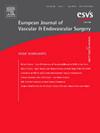在两家中心实施血管内主动脉综合计划并在瓣膜分支血管内主动脉修复过程中保持临床卓越性。
IF 5.7
1区 医学
Q1 PERIPHERAL VASCULAR DISEASE
European Journal of Vascular and Endovascular Surgery
Pub Date : 2025-03-01
DOI:10.1016/j.ejvs.2024.11.014
引用次数: 0
摘要
目的:全面的血管内主动脉计划需要最佳的基础设施和多学科团队来管理复杂的主动脉瘤。本研究评估了两个中心实施此类计划的情况及其对栅栏式分支血管内主动脉修复术(FB-EVAR)疗效的影响:方法:对2013年至2023年间接受FB-EVAR治疗的复杂腹主动脉瘤和胸腹主动脉瘤(TAAA)患者进行回顾性研究。对所有 FB-EVAR 患者进行了分析,包括研究试验和使用医生改良内植物的高风险患者。对第一中心(2013 - 2020 年)和第二中心(2020 - 2023 年)进行了比较。主要终点是30天/住院死亡率和主要不良事件(MAE)。次要终点是手术指标、脊髓损伤、全因死亡率、抢救失败率、一年死亡率和再干预率:共纳入 629 名患者(475 名,75.5% 在第一中心;154 名,24.5% 在第二中心)。中位年龄为 74 岁(四分位数区间为 68 至 79 岁),男性 441 人(占 70%)。美国麻醉学会分级≥3级、遗传引发的主动脉疾病(p = .002)、切除后慢性动脉瘤、既往主动脉修复、TAAA(各p < .001)和无症状、较大动脉瘤(p < .021)的比例在中心2更高。各中心的技术成功率相似(98% vs. 98%; p = .91)。早期死亡率为 1.1%(7/629),差异无统计学意义。在新发永久性透析(0.6% vs. 2.0%)、重大中风(0.6% vs. 0.6%)和永久性截瘫(0.8% vs. 2.0%)方面没有观察到明显的统计学差异(p > .050)。中心 2 的抢救失败率为 5%,中心 1 为 3.5%(p = .74)。各中心的一年死亡率(91% vs. 89%; p = .71)和再介入率(SHR 1.30; p = .21)相似:结论:栅栏式分支血管内主动脉修复术的死亡率和致残并发症风险较低。结论:尽管新机构的病例风险更高、范围更广,但在建立了全面的血管内手术计划后,死亡率和MAEs并无差异。本文章由计算机程序翻译,如有差异,请以英文原文为准。
Implementation of a Comprehensive Endovascular Aortic Programme and Maintenance of Clinical Excellence during Fenestrated Branched Endovascular Aortic Repair in Two Centres
Objective
Comprehensive endovascular aortic programmes need optimal infrastructure and multidisciplinary teams to manage complex aortic aneurysms. This study assessed the implementation of such a programme in two centres and its impact on fenestrated or branched endovascular aortic repair (FB-EVAR) outcomes.
Methods
A retrospective review of patients treated for complex abdominal and thoraco-abdominal aortic aneurysms (TAAAs) by FB-EVAR between 2013 and 2023 was undertaken. All FB-EVAR patients were analysed, including investigational trials and high risk patients with physician modified endografts. Centre 1 (2013 – 2020) and Centre 2 (2020 – 2023) were compared. Primary endpoints were 30 day and or in hospital mortality and major adverse event (MAE) rates. Secondary endpoints were procedural metrics, spinal cord injuries, freedom from all cause death, failure to rescue, and one year mortality and re-intervention rates.
Results
A total of 629 patients were included (475, 75.5% at Centre 1 and 154, 24.5% at Centre 2). The median age was 74 years (interquartile range 68, 79) and 441 (70.1%) were male. Centre 2 had a higher proportion of American Society of Anesthesiology class ≥ 3, genetically triggered aortic diseases (p = .002), chronic post-dissection aneurysms, prior aortic repairs, TAAAs (each p < .001), and symptomatic, larger aneurysms (p < .021). Technical success rates were similar between centres (97.9% vs. 98.1%; p = .91). The early mortality rate was 1.1% (7/629) with no statistically significant difference. No statistically significant differences (p > .050) in new onset permanent dialysis (0.6% vs. 2.0%), major stroke (0.6% vs. 0.6%), and permanent paraplegia (0.8% vs. 2.0%) were observed. Failure to rescue rates were 5.3% in Centre 2 and 3.5% in Centre 1 (p = .74). The one year mortality rate (91% vs. 89%; p = .71) and re-intervention rate (sub-distribution hazard ratio 1.30; p = .21) were similar between centres.
Conclusion
FB-EVAR was performed with low mortality and risk of disabling complication rates. No differences in mortality and MAE rates were observed after establishing a comprehensive endovascular programme, despite higher risk and more extensive cases at the new institution.
求助全文
通过发布文献求助,成功后即可免费获取论文全文。
去求助
来源期刊
CiteScore
6.80
自引率
15.80%
发文量
471
审稿时长
66 days
期刊介绍:
The European Journal of Vascular and Endovascular Surgery is aimed primarily at vascular surgeons dealing with patients with arterial, venous and lymphatic diseases. Contributions are included on the diagnosis, investigation and management of these vascular disorders. Papers that consider the technical aspects of vascular surgery are encouraged, and the journal includes invited state-of-the-art articles.
Reflecting the increasing importance of endovascular techniques in the management of vascular diseases and the value of closer collaboration between the vascular surgeon and the vascular radiologist, the journal has now extended its scope to encompass the growing number of contributions from this exciting field. Articles describing endovascular method and their critical evaluation are included, as well as reports on the emerging technology associated with this field.

 求助内容:
求助内容: 应助结果提醒方式:
应助结果提醒方式:


